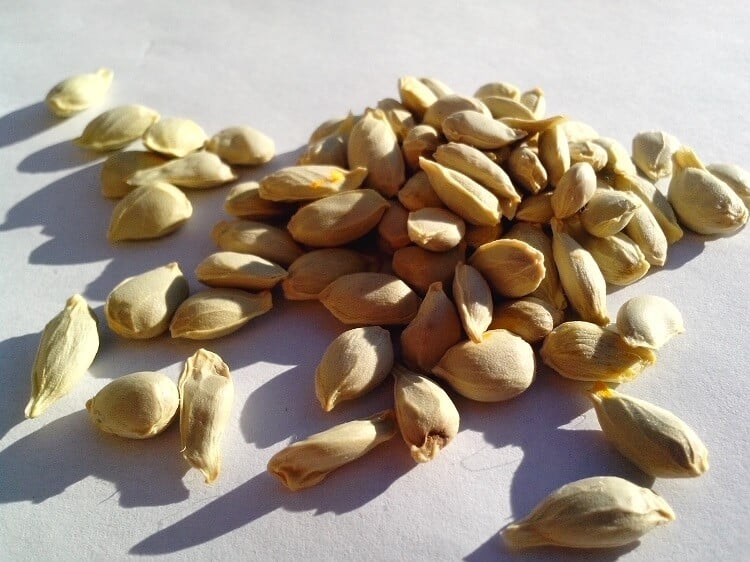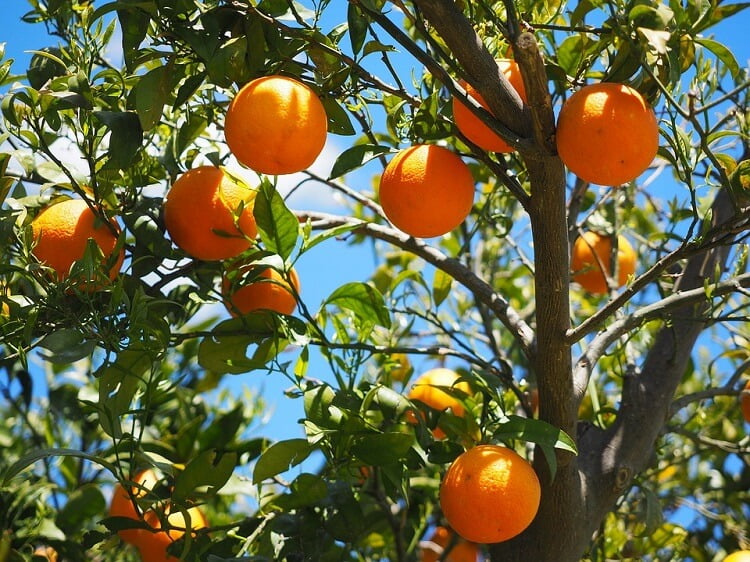Are the Pruning Techniques for Peach Trees Similar to Orange Trees?
Pruning a peach tree step-by-step differs from pruning orange trees. The techniques for each tree are unique due to their distinct growth habits and fruiting patterns. While both require opening up the center to maximize sunlight and airflow, peach trees need more aggressive pruning to avoid overcrowding and ensure healthy fruit production. It’s essential to understand the specific needs of each tree to apply the correct pruning techniques.
Can I Use Flowering Shrubs to Complement My Orange Trees in Landscaping?
Can I use top flowering shrubs for landscaping to complement my orange trees? Absolutely! Flowering shrubs such as hydrangeas, lilacs, and azaleas can add vibrant pops of color that beautifully complement the oranges of your citrus trees. These stunning shrubs will enhance the aesthetic appeal of your landscaping, creating a harmonious and visually appealing outdoor space.
Planting Orange Trees 101
1. Choose the Right Seeds
Before planting, you must know that if you grow an orange tree from a seed it will be more vulnerable. At the same time, the taste may not be the same as the one of the original fruit where you took the seed from. It may even take 4-5 years for the tree to produce fruits. Meanwhile, if you buy a young tree from the nursery, you will have a combination of varieties. The result there is a mix between one tree bred that has healthy roots and a tree with high-quality fruit. If you decide to plant from a seed, you should know how to choose the best ones. The seeds need to be chosen before they dry out. They don’t have to be damaged by the knife or have any discolorations, dents etc.
2. Prepare the Seeds
Now you need to wash the seeds. Hold them under running water and take off pulp or other material. Be careful with them, especially if some are already sprouting. It is important to keep them moist since this will make them more likely to sprout. One option for this is to put them in a plastic bag and keep them in the refrigerator for 30 days. Alternatively, you can keep the soil where you place them moist. However, it shouldn’t be soggy.3. Plant the Seeds
You can plant the seed in a small pot. It is important to choose a type of soil or a potting mix that is well-draining. Place the seeds ½ inch (1.2 cm) below the surface. The best part is that this plant is not too picky when it comes to the potting mix. However, it’s essential to make sure that water doesn’t pool around the seeds or roots because they will rot. Another option is to use citrus potting compost and add it to the mix. This will enable it to hold more nutrients and the orange trees will have a more acidic environment to grow in. If you have a poor-draining soil, use some hardwood bark chips. This will make it less compact, thus letting the water drain faster.
4. Ensure Adequate Light Distribution
Even if you plant indoors or outdoors, the soil thrives in temperatures between 24° and 29°C (75° and 85°F). Thus, the best way to keep the soil warm is to place it in sunlight. If you use a radiator, this might cause the soil to dry out quickly, which is the last thing you want when planting orange trees. If the area you live in is a cold one or it doesn’t have too much sun, a heated greenhouse is a great solution.5. Fertilize
Fertilizers are a great way of improving the tree growth rate. If you want to do that, you should add a little bit of fertilizer to the soil every 10 or 14 days. For the best results, adjust the type of fertilizer according to the amount of nutrients in the soil. You can find this information on the label of the soil you bought. If not, you can simply go for a balanced fertilizer. Once the plant grows and becomes a young tree, you don’t need to add fertilizer anymore.6. Choose the Best Sprout
Usually, you will see three sprouts when planting orange trees. Citrus seeds have a very strange tendency of making clones of the mother plant. The nu-cellar seedlings, as they are called, are usually the two sprouts that grow the fastest. The third one has the tendency of being smaller and growing slower. You need to cut this one out if you want to make a tree of good quality.
7. Plant It into a Larger Pot
When growing from a seedling, you need to plant the tree into a bigger pot whenever its roots grow bigger than the one it is in. The roots should fit comfortably into the pot, but the container shouldn’t be much larger. Spring is the best time to re-pot the orange tree since it doesn’t grow that much until then. Before making this step, you should cut off the dead or broken roots. Use a sterilized knife for this to eliminate the risk of disease.8. Choose an Outdoor Location
If you live in the US, you should know that oranges grow in the USDA planting zones numbered 8 to 10. Here you will find an annual temperature of 10 to 40°F, which is -12 to 4.4°C. The area where you plant needs to be protected from the wind. When planting orange trees, allow for a minimum of 12 feet (3.7 meters) of space away from walls or other big obstacles. Moreover, they should be 25 feet (7.6 meters) away from other trees.9. Use the Existing Soil
Dig a hole with a depth sufficient to cover the roots. Then, put the soil you dug out over the roots. If you use a potting mix and your regular soil, it might retain too much water. The danger here is that the trees may rot if they have too much water. Careful! The trunk shouldn’t be covered in soil, or the tree may die.10. Full Sun
Just like we discussed with planting orange trees from a seed, you must pay attention to the young seedlings. The ideal temperatures are the ones mentioned above. You need to know that orange trees do poorly if the temperature drops below 45°F (which is 7°C). If frost is coming, you should move the tree indoors. If the temperatures reach more than 100°F (38°C), you should protect it with a sun shade or a sheet.
11. Water According to Its Needs
Young orange trees prefer a soil that gets the chance to dry out before getting some more water. Make a deep hole by using your finger, and water heavily only when the soil feels dry. Usually, you should water the orange tree 1-2 times a week. However, this is not a rule, since there are many factors that count: humidity, temperature, sunlight. If you have a hard tap water, choose a filtered one instead, or even rainwater.12. Clean the Plants
If you move the trees indoor, you should make sure the plants are clean. Brush or rinse the leaves every 2-3 weeks to remove dust or grime. If the air is rather polluted where you live, you should do that with the outdoor plants as well.13. Not that much Pruning
Citrus trees, in general, can manage without pruning. You will only need to remove the dead branches or the suckers that don’t look good next to the base. Many prefer to prune the tree to give it a certain shape or growing direction. You may even do this to keep it short so that it’s easier to harvest. If you choose to do so, cut the heavy branches in winter, otherwise, the inner tree might be vulnerable to sunburns. Here you have a short clip that will show you the entire procedure step by step:Troubleshooting Tips
Here you have some useful tips in case you happen to run into some problems when planting orange trees.1. Use Newspaper on the Trunk
In case of sunburn or withering, it’s a good idea to tie some newspapers loosely around the affected areas. You can use this as a prevention method for the areas where the sun is really strong.2. Test the Soil PH
When planting orange trees, many people are wondering why do their leaves turn yellow. This is a clear sign that there is too much base salt. In this case, use a soil tester test out the PH of the soil to check for the alkalinity. In case it’s too alkaline, use an acidic fertilizer and wash the soil to remove the salts.









